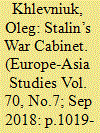| Srl | Item |
| 1 |
ID:
167549


|
|
|
|
|
| Summary/Abstract |
This essay reviews the characteristic features of the Soviet ‘shadow economy’ by examining the activities of a major construction enterprise headed by N. M. Pavlenko from 1948 to 1952. This was the largest currently known private illegal enterprise of the Stalinist period. Pavlenko’s organisation built dozens of roads and railways under contract to state entities. Based on newly accessible archival documents, the methods of Pavlenko’s organisational activity and the reasons for its lengthy existence are considered. The author argues that, regardless of its extraordinary scale, Pavlenko’s enterprise was in fact typical of the Stalinist ‘shadow economy’, and that future archival research would probably reveal that this shadow economy was far more significant than has been understood to date.
|
|
|
|
|
|
|
|
|
|
|
|
|
|
|
|
| 2 |
ID:
185334


|
|
|
|
|
| Summary/Abstract |
During the years of the war between the Soviet Union and Nazi Germany, the Stalinist system of rule changed. Under the extreme circumstances of war, the practices of collective leadership expanded at the highest levels of power, while regional governance and state ministries were decentralised. An important aspect of this process of change was the revision of Stalin’s relationship with the military leadership. This article examines three interrelated phenomena central to the reconstruction of Stalin’s trust in his generals. The first is the evolution of the policy of repression from arrests and executions to demotions. The second is the relaxation of political control together with the elevation of the status of the army command. The third is a shift in strategies for addressing the dictator’s dilemma, that is, the contradictions between the growing influence of those who carry out orders (in this case, military leaders) and the further consolidation of Stalin’s sole authority.
|
|
|
|
|
|
|
|
|
|
|
|
|
|
|
|
| 3 |
ID:
161367


|
|
|
|
|
| Summary/Abstract |
Amid the extensive literature on the Stalinist dictatorship during the 1930s and the postwar period, the gap in scholarship on the Soviet leadership during the war years is particularly noticeable. This article fills that gap. Stalin’s war cabinet is characterised according to several criteria: first, the formal status of members of the leadership; second, the system of delegating authority; third, the functioning and competency of the structure of collective leadership; and fourth, Stalin’s loyalty to his top associates and the degree of their political immunity. The article demonstrates that the war years saw a relative ‘normalisation’ of the dictatorship. These important changes influenced the subsequent development of the Stalinist system of power and the evolution of Soviet authoritarianism after the dictator’s death.
|
|
|
|
|
|
|
|
|
|
|
|
|
|
|
|